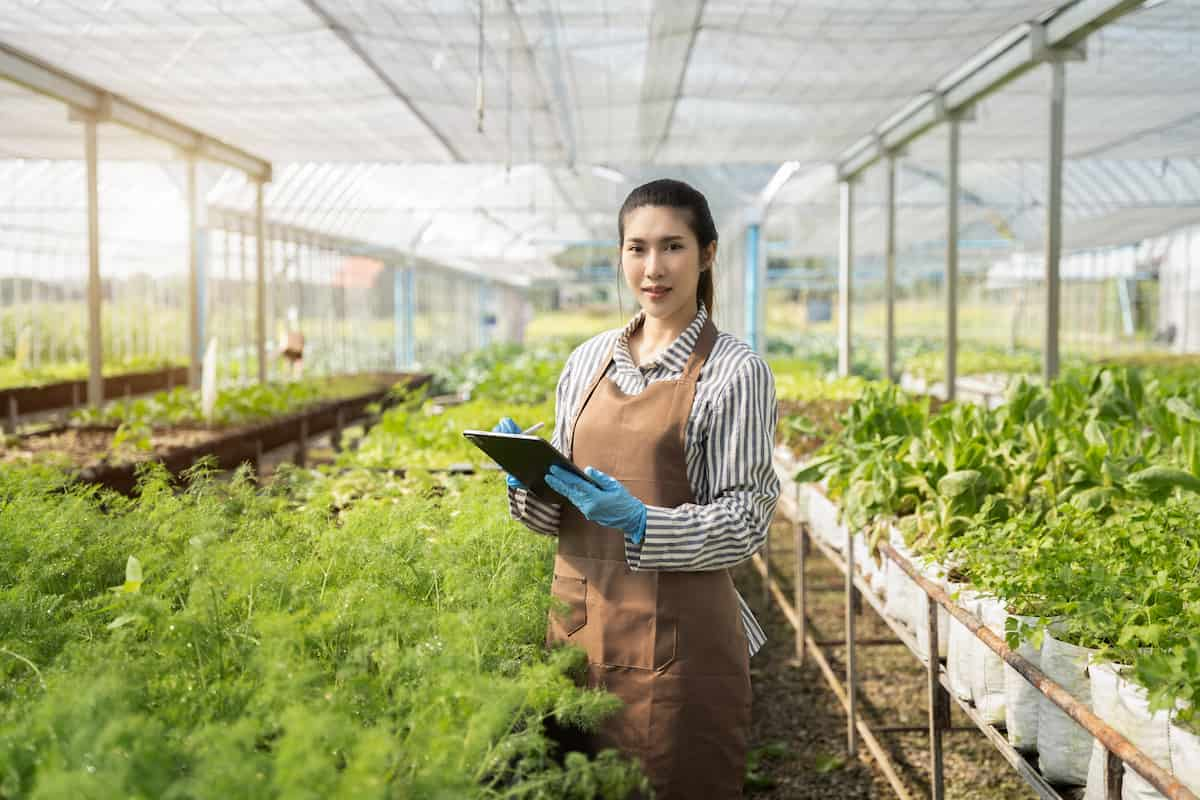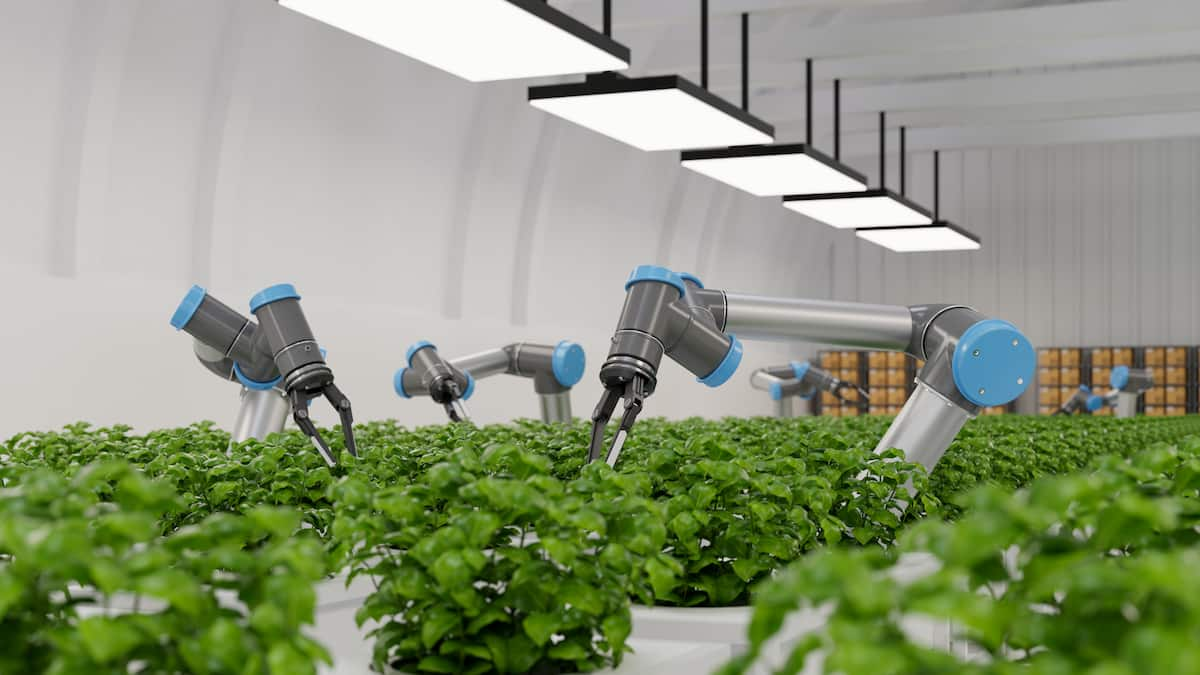The greenhouse farming technique improves the yields of crops, vegetables, fruits, etc. In greenhouses, environmental parameters are controlled either manually or proportionally. Manual intervention, however, is less effective due to production losses, energy losses, and labor costs. Smart greenhouses monitor and control the climate intelligently using IoT-embedded systems. Thus eliminating the need for human intervention.

Smart Farming in Greenhouse
Different Sensors Used to Automate a Greenhouse
The Smart Greenhouse is equipped with multiple wireless sensors. Sensors measure temperature, humidity, lighting intensity, and carbon dioxide levels, and the data collected is exported to an edge computer. Moreover, this data is stored in the cloud as well. A single computer-controlled each piece of equipment, and multiple environmental conditions were managed individually. The position and number of each piece of equipment were limited since they were wired.
In a Smart Greenhouse, a single computer controls multiple equipment pieces, minimizing wiring, and all data are automatically collected through a wireless network to the edge computer. Each setting for the cultivating environment to water the crops are automatically controlled based on a predetermined formula, so there is no need to go back and forth to the greenhouse.
Smart greenhouses use sensors that measure environmental parameters according to plant requirements. A cloud server is created for remote access when the IoT system is connected. For controlling the environment in the smart greenhouse, various sensors are used to measure the environmental parameters of the plant requirement:
Soil Moisture Sensor
This sensor measures moisture content and provides soil moisture levels and similar information. Different crops require different water levels, which an agronomist determines. It consists of two large pads that serve as probes for the sensor to detect moisture levels. Because of the lack of moisture level in the soil, the analog voltage will be low, increasing the conductivity between electrodes. A sensor like this is ideal for automatically watering flower plants. Moreover, soil moisture sensors can also monitor greenhouse air humidity and heat levels.
Light Sensor
Due to the high demand for food and the growing world population, agricultural yields are low despite fertile land and many other resources. Consequently, technology integration has become crucial in agriculture because it minimizes labor costs, effort, and time. Sensing the greenhouse data in real time and transmitting it to the user device is the main function of the deployed sensors. Thus, farmers can control light, water, and temperature via mobile devices.
Humidity & Weather Monitoring Sensor
In the agricultural industry, greenhouse farming has tighter constraints than traditional farming. Plant growth depends heavily on weather variables, which must be constantly controlled. While implementing IoT-enabled greenhouse farming, limitations of the proposed smart solution, improvements in accuracy, and cost are crucial factors.
Integrating IoT sensors with mathematical models allows growers to take corrective measures before an outbreak occurs. The greenhouse’s physical internal and external conditions can be analyzed effectively using temperature, humidity, water, CO2, NH3, pH, etc.
In case you missed it: Top 10 Applications of Artificial Intelligence (AI) in Agriculture

Advantages of Smart Greenhouse Automation
Keep the Micro-Climate as Close to Ideal as Possible
Sensors connected to the Internet of Things (IoT) allow farmers to gather information at a much finer scale. The sensors provide real-time information on greenhouse environmental factors such as temperature, humidity, light exposure, and carbon dioxide levels. Crop growth cycles and other relevant information are recorded by sensors so that growers can plan for future plantings.
Using this data, HVAC and lighting settings can be adjusted to maximize plant growth while conserving energy. The use of motion or acceleration sensors can identify doors that have been accidentally left open, thereby ensuring a highly controlled environment.
Improve Irrigation and Fertilization Practices
Using smart greenhouses can help farmers monitor their farms from all angles, including temperature, humidity, and sun exposure. This ensures that fertilization and irrigation activities match cultivated plants’ needs to maximize yields. For example, soil volumetric water content readings indicate whether crops are suffering from water stress. On the other hand, soil salinity levels provide valuable information about fertilizer requirements.
Avoiding Early Detection and Treatment of Disease Outbreak
Infections in crops are a persistent problem for farmers, causing significant damage to crop margins with every epidemic. The application of agrochemicals is accessible to farmers, but they may not know when to do so. It’s important to use agricultural pesticides as needed and to limit their use. When treatments are overused, they may have environmental, safety, and cost concerns; when they are not applied, they may cause epidemics of deadly diseases.
Reduce Theft And Improve Security
Crops grown in greenhouses with high value make them attractive targets for robbers. Due to the costs associated with setting up traditional CCTV networks, many farmers lack a viable security system. In this case, IoT sensors in smart greenhouses provide an inexpensive means for monitoring the status of doors and detecting suspicious behavior. When an automated alarm system detects a security problem, they notify farmers immediately.
Challenges in Transforming to Smart Farming in Greenhouse Using IoT Technology
- Choosing the suitable sensors for your device is crucial to building an IoT solution for agriculture. Choosing a solution will depend on the type of information you want to collect and its general purpose. Anyhow, the accuracy and reliability of the data collected by your sensors are crucial to the success of your product.
- Maintenance is a primary challenge for IoT products in agriculture because sensors are typically used in the field and can be damaged easily.
- You need a solid internal infrastructure to ensure that your smart farming application performs well (and can handle the data load). Additionally, your internal systems must be secure. Failing to secure your system properly increases the chances that someone will break in, steal your data, and even control your autonomous tractors.
- It is still difficult to adopt smart farming because of the need to transmit data between many agricultural facilities. The connection between these facilities must be reliable enough to withstand bad weather conditions and to ensure that the operations will not be interrupted.
- It is difficult to determine the optimal data collection frequency in the agricultural industry because of the wide variety of data types. Regulations and restrictions may apply to data from field-based, aerial, and environmental sensors, apps, machinery, equipment, and process analytical data.
In case you missed it: Automation and Robotics in Greenhouse Farming

Conclusion
Using the temperature, moisture, humidity, and light sensors, the greenhouse management system (control and monitoring) monitors the environmental changes to adjust the driver circuits so that the greenhouse climatic conditions remain normal. The IOT platform enables remote monitoring and control of greenhouses. The cloud service stores the information and sends regular SMS updates to the farmer about the conditions in the room.
- Feed Your Flock for Less: Top 10 Tips to Save on Chicken Feed
- Ultimate Guide to Ossabaw Island Hog: Breeding, Raising, Diet, and Care
- Hatching Answers: The Top 10 Reasons Your Chickens Aren’t Laying Eggs
- Eggs and Economics: Breaking Down the Cost of Raising Backyard Chickens
- Defend Your Greens: Proven Methods to Keep Iguanas Out of Your Garden
- Ultimate Guide to Cinnamon Queen Chicken: A Comprehensive Guide for Beginners
- Ultimate Guide to California Tan Chicken: Breeding, Raising, Diet, Egg-Production and Care
- Ultimate Guide to Marsh Daisy Chicken: Breeding, Raising, Diet, and Care
- 10 Types of Chicken Farming Businesses You Can Start for Profits